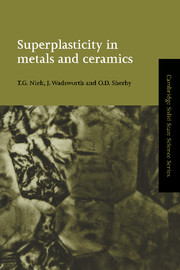Book contents
- Frontmatter
- Contents
- Preface
- Chapter 1 Introduction
- Chapter 2 Key historical contributions
- Chapter 3 Types of superplasticity
- Chapter 4 Mechanisms of high-temperature deformation and phenomenological relations for fine-structure superplasticity
- Chapter 5 Fine-structure superplastic metals
- Chapter 6 Fine-structure superplastic ceramics
- Chapter 7 Fine-structure superplastic intermetallics
- Chapter 8 Fine-structure superplastic composites and laminates
- Chapter 9 High-strain-rate superplasticity
- Chapter 10 Ductility and fracture in superplastic materials
- Chapter 11 Internal-stress superplasticity (ISS)
- Chapter 12 Other possible superplasticity mechanisms
- Chapter 13 Enhanced powder consolidation through superplastic flow
- Chapter 14 Superplastic forming and diffusion bonding
- Chapter 15 Commercial examples of superplastic products
- Index
Chapter 9 - High-strain-rate superplasticity
Published online by Cambridge University Press: 15 October 2009
- Frontmatter
- Contents
- Preface
- Chapter 1 Introduction
- Chapter 2 Key historical contributions
- Chapter 3 Types of superplasticity
- Chapter 4 Mechanisms of high-temperature deformation and phenomenological relations for fine-structure superplasticity
- Chapter 5 Fine-structure superplastic metals
- Chapter 6 Fine-structure superplastic ceramics
- Chapter 7 Fine-structure superplastic intermetallics
- Chapter 8 Fine-structure superplastic composites and laminates
- Chapter 9 High-strain-rate superplasticity
- Chapter 10 Ductility and fracture in superplastic materials
- Chapter 11 Internal-stress superplasticity (ISS)
- Chapter 12 Other possible superplasticity mechanisms
- Chapter 13 Enhanced powder consolidation through superplastic flow
- Chapter 14 Superplastic forming and diffusion bonding
- Chapter 15 Commercial examples of superplastic products
- Index
Summary
It is often thought that superplasticity is only found at relatively low strain rates, typically about 10–4 to 10–3 s–1. Several recent studies have indicated, however, that superplasticity can exist at strain rates considerably higher than 10–2 s–1. This high-strain-rate superplasticity (HSRS) phenomenon has now been observed in metal-matrix composites, mechanically alloyed materials, and even the more conventionally produced metallic alloys. We will discuss the phenomenon in detail in the following.
Experimental observations
Metal-matrix composites
The phenomenon of HSRS was initially observed in Al-based metal-matrix composites and has continued to be studied mainly in Al-based alloys. Composite reinforcements include SiC and Si3N4 whiskers and SiC particles; matrix alloys include 2000, 6000, and 7000 series Al. A list of published HSRS results is presented in Table 9.1. Despite the differences in the type of reinforcement and matrix composition, all of these composites are noted to exhibit approximately similar deformation and microstructural characteristics. In the following, we use a powder-metallurgy 20%SiC whisker-reinforced 2124Al composite (SiCw/2124Al) as an example to reveal the key experimental observations of HSRS. This composite was the first material observed to exhibit HSRS.
To the present time, reports on HSRS are found in aluminum composites mainly produced by powder-metallurgy methods. High-temperature deformation investigations of the SiCw/2124Al indicated that the material was not superplastic in as-extruded conditions; over the conventional strain-rate range of 1.7×10–3 to 3.3×10–1 s–1, elongation-to-failure values of 30 to 40% were recorded.
- Type
- Chapter
- Information
- Superplasticity in Metals and Ceramics , pp. 154 - 188Publisher: Cambridge University PressPrint publication year: 1997
- 7
- Cited by



